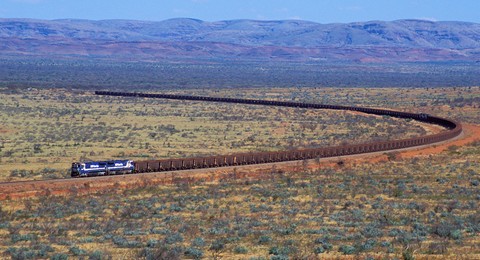
The most gargantuan machines on Earth usually operate far outside the public eye, in remote corners of the globe where the substances that make modern life possible are extracted from the ground. We’ve previously posted about one such device, an abandoned component of a German coal-mining operation. Today we’d like to focus on another plus-sized metal marvel: The locomotives that haul Western Australian coal from Newman to Nelson Point:
The 426-kilometre railway line from Newman to Nelson Point is one of Australia’s longest privately-owned railways. It services the mines – with spur lines to Mt Whaleback, Orebodies 18, 23, 25 and 29, Jimblebar, Yandi and Area C – with the longest and heaviest trains in the world.
A typical train will have six, 6,000 horsepower locomotives pulling more than 26,000 tonnes of ore. Most trains are 208 cars, each carrying approximately 125 tonnes of ore.The trains are up to 3.75 kilometres long and the journey from Newman to Port Hedland takes approximately eight hours.
Once you finish being wowed by the sheer scale of the system, however, you start to realize why such projects complicate our move toward a lower-carbon future. So many billions of dollars have been invested in the coal-mining infrastructure, and entire regions—even nations—are dependent on the continued extraction of ore. If we’re truly intent on decreasing our coal consumption, what is to become of these systems? Do we leave them to decay into ghosts? Or can they be repurposed for cleaner ends? And how do you convince the politically mighty likes of BHP Billiton to go along with whatever the plan may be?
(Image via John Kirk at RailPictures.net)


Jordan // Jun 17, 2009 at 2:21 pm
I just listened to the Economist’s article about the joining of BHP and Rio’s iron ore operations in Australia and they quote some of the same statistics.
It also says a lot about the relative costs of shipping and power/labor in the first world that it makes more sense to ship tons of value-density poor ore than finished iron and steel across the oceans. It’ll be interesting to see if this becomes more or less prevalent with the continued integration of world markets and the accompanying flattening of labor costs. The cost of power may end up being the decisive factor in where goods are produced.
Brendan I. Koerner // Jun 17, 2009 at 3:12 pm
@Jordan: The tricky part is accounting for the inevitable fluctuations in the cost of that power. Tiny variations in price can totally kill a mammoth operation that relies on volume to compensate for small margins.
Jordan // Jun 17, 2009 at 3:18 pm
Proving that they can provide consistency will probably be the biggest hurdle for renewable power supplies to get over. Hence systems like thermal solar power generators that can be supplemented by natural gas or store excess heat in molten salts seem important. I also wonder if this may make geothermal power a bigger player in the end as the heat of the planet’s core is more or less constant and inexhaustible at our current level of technology.
Brendan I. Koerner // Jun 17, 2009 at 3:20 pm
@Jordan: Really want to write about geothermal, b/c I agree that it’s likely more promising than solar (at least given current panel tech). If you know of any nascent projects that might be worth deeper exploration (pun intended), pls drop me a line.